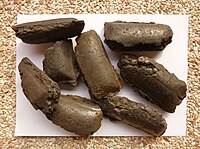
Photo from wikipedia
Hydrogen-based direct reduction is a promising technology for CO2 lean steelmaking. The electric arc furnace is the most relevant aggregate for processing direct reduced iron (DRI). As DRI is usually… Click to show full abstract
Hydrogen-based direct reduction is a promising technology for CO2 lean steelmaking. The electric arc furnace is the most relevant aggregate for processing direct reduced iron (DRI). As DRI is usually added into the arc, the behavior in this area is of great interest. A laboratory-scale hydrogen plasma smelting reduction (HPSR) reactor was used to analyze that under inert conditions. Four cases were compared: carbon-free and carbon-containing DRI from DR-grade pellets as well as fines from a fluidized bed reactor were melted batch-wise. A slag layer’s influence was investigated using DRI from the BF-grade pellets and the continuous addition of slag-forming oxides. While carbon-free materials show a porous structure with gangue entrapments, the carburized DRI forms a dense regulus with the oxides collected on top. The test with slag-forming oxides demonstrates the mixing effect of the arc’s electromagnetic forces. The cross-section shows a steel melt framed by a slag layer. These experiments match the past work in that carburized DRI is preferable, and material feed to the hotspot is critical for the EAF operation.
Journal Title: Metals
Year Published: 2023
Link to full text (if available)
Share on Social Media: Sign Up to like & get
recommendations!